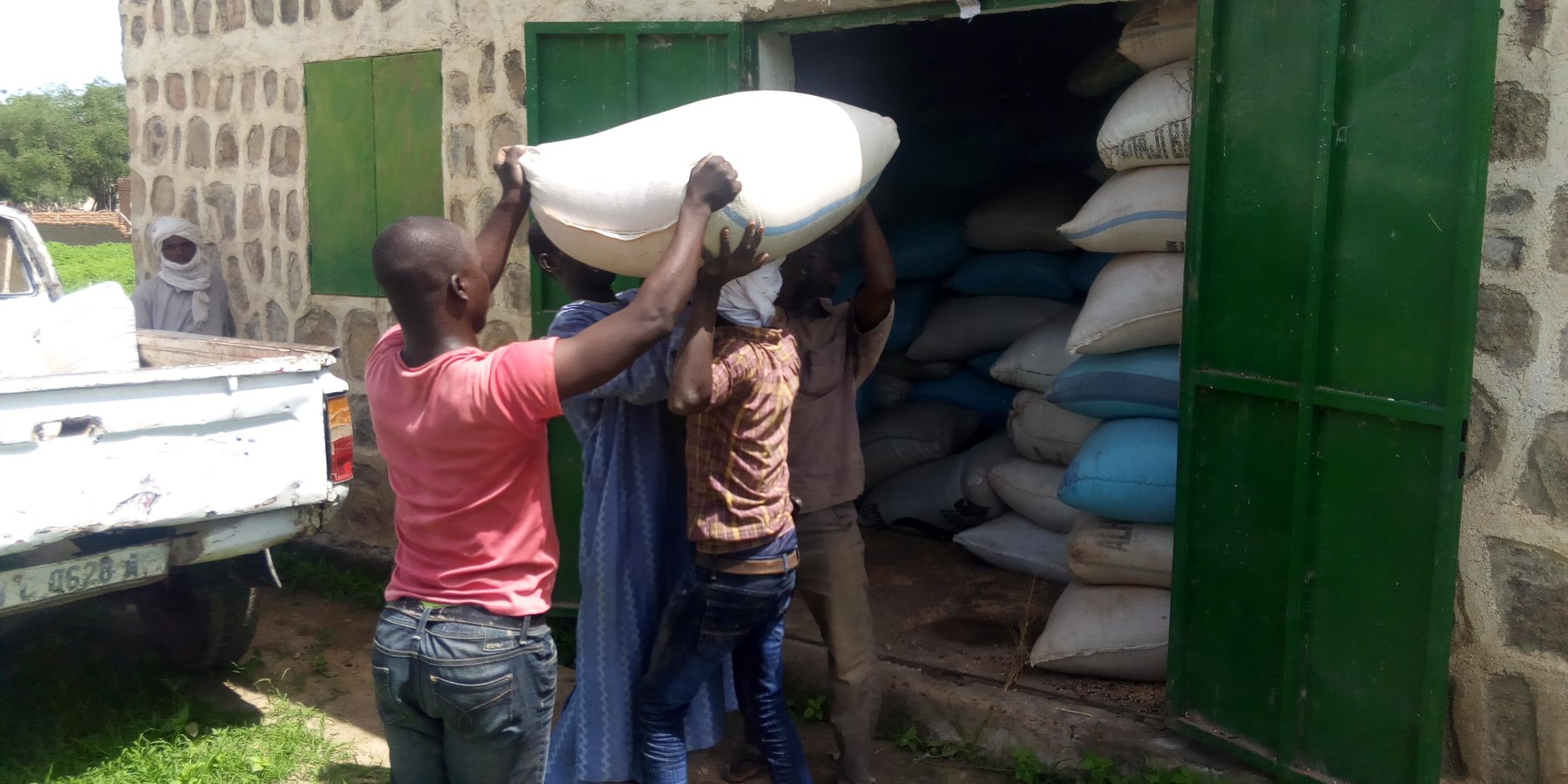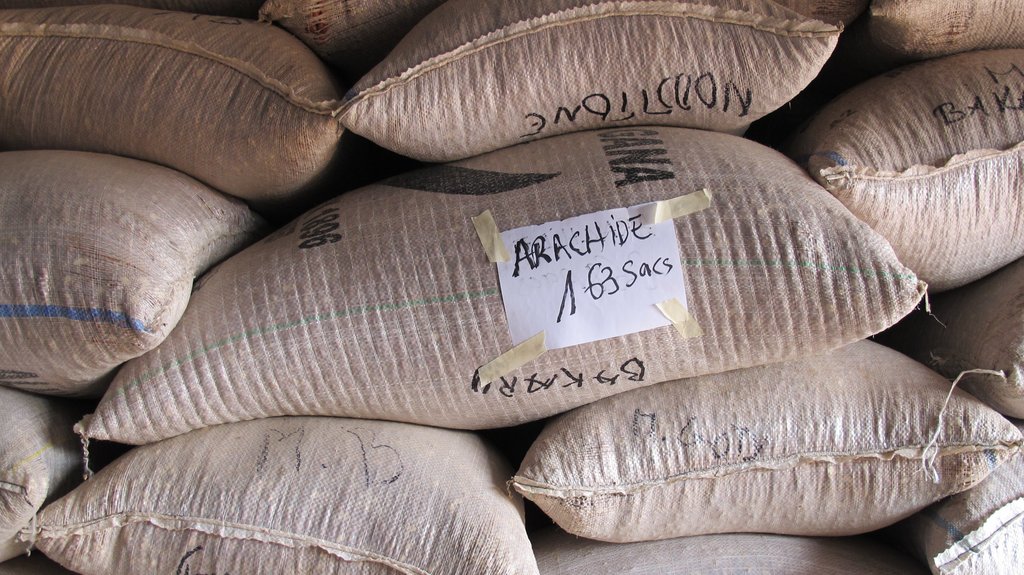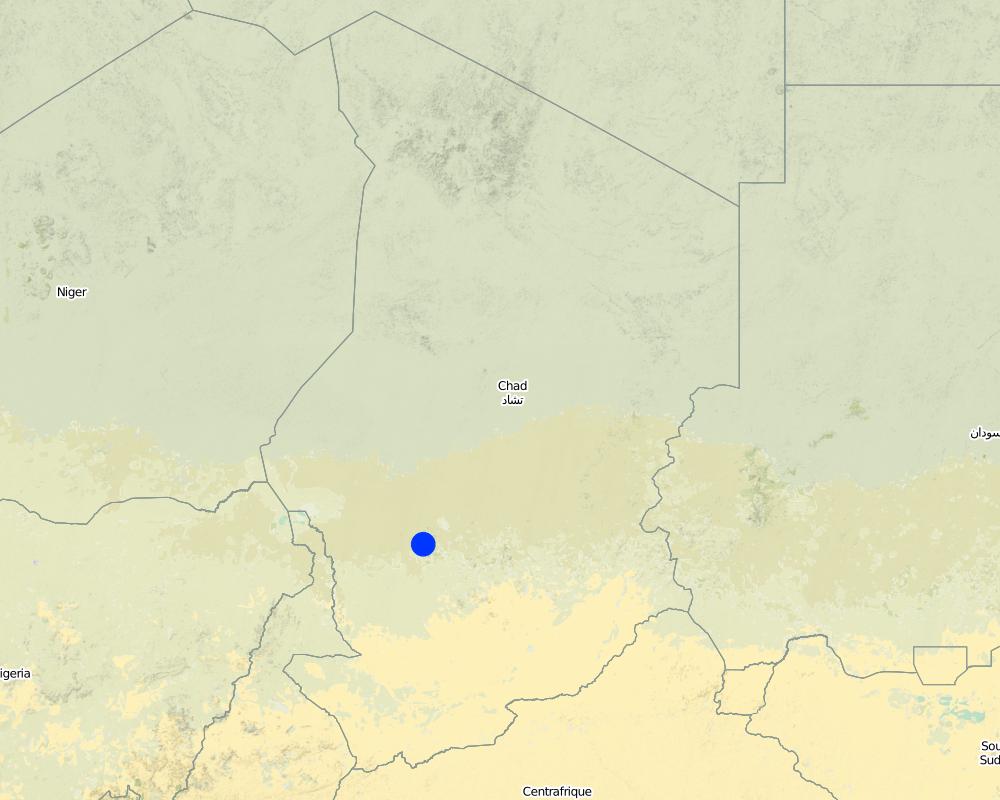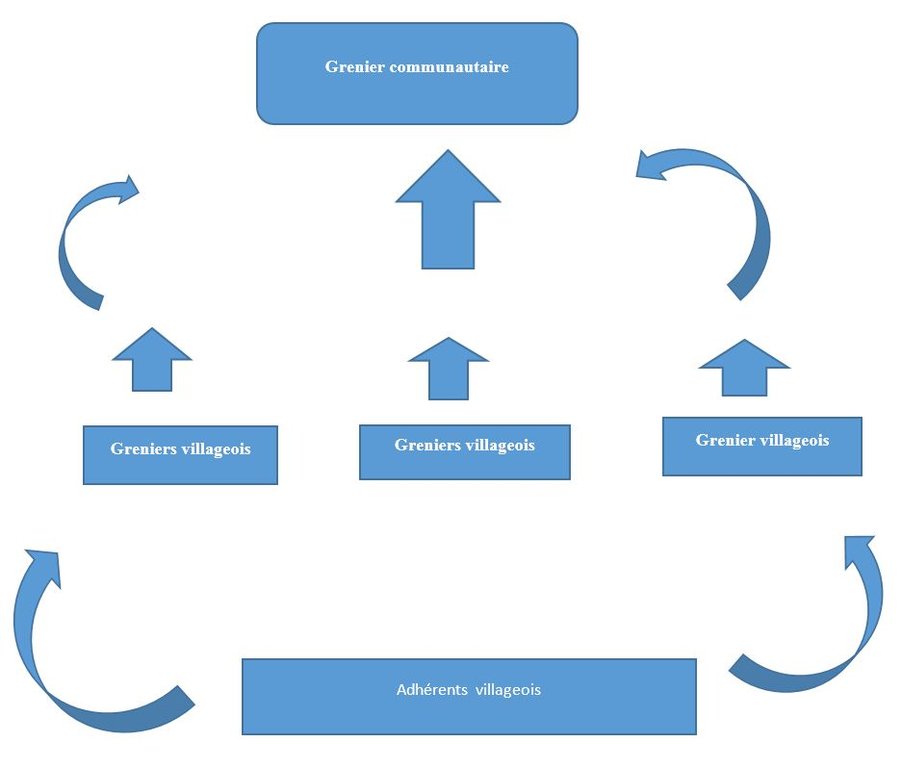Community storage shed [Chad]
- Creation:
- Update:
- Compiler: Mahamat Moussa Absakine
- Editors: Boris Orlowsky, Nicole Stolz, Mahamat Moussa Absakine, David Beritault
- Reviewers: David Beritault, Deborah Niggli
Dabanga
approaches_1773 - Chad
View sections
Expand all Collapse all1. General information
1.2 Contact details of resource persons and institutions involved in the assessment and documentation of the Approach
Name of project which facilitated the documentation/ evaluation of the Approach (if relevant)
Book project: where people and their land are safer - A Compendium of Good Practices in Disaster Risk Reduction (DRR) (where people and their land are safer)Name of the institution(s) which facilitated the documentation/ evaluation of the Approach (if relevant)
CARITAS (Switzerland) - Switzerland1.3 Conditions regarding the use of data documented through WOCAT
The compiler and key resource person(s) accept the conditions regarding the use of data documented through WOCAT:
Yes
2. Description of the SLM Approach
2.1 Short description of the Approach
Community storage sheds contribute to the food security of vulnerable rural households by facilitating access to stocks and the availability of food during the period between harvests (shortage). The approach makes it possible to mobilize a community with the intention to establish a storage shed for food security at the village level.
2.2 Detailed description of the Approach
Detailed description of the Approach:
Climate change is a challenge at global level that all mankind is facing. The farmers of the Sahel in general, and of Dababa in particular, are the most exposed. The precipitation patterns have been disturbed to a large degree in the past years. Formerly, 1 out of 10 years was bad, but today, this is 1 out of 3 years. The farmers of Bokoro already notice the manifestations of climate change such as the delay and the abrupt changes in rainfall, the increase of the temperature, the frequency of strong winds, the renewed outbreak of certain diseases (human pathologies), drought etc. In order to face the impacts, the agricultural producers have developed different adaptation strategies like the establishment of storage sheds.
A community storage shed is a mechanism of mutual aid to support vulnerable persons through the distribution of food supplies during the period between harvests (shortage), and also the distribution of seeds to start the new cropping season. The quantity granted to each household will be reimbursed at the harvest, in kind, to replenish the stock. An interest rate, established by common agreement, enables to insure expenses related to the functioning of the storage shed (maintenance of the storage accommodation, conservation products, etc.). The same interest rate is applied to all beneficiaries of credits. A manual for the procedure of credit management is available and is applied. The interest rate is fixed and can vary between villages. The building protects the stocks from moisture, fire and from the destruction of cereals by rodents.
Generally, institutions (NGOs and other participants) provide the first stocks of food supplies to the villages, and support them in the management of these stocks. It is also possible to lead the population, by awareness raising campaigns, to build the initial stock themselves.
The different stages of the approach are the following:
- Identification of the target villages and assessment of the agricultural production, in a partnership between ACORD, the Department Action Committee (DAC), and the village chiefs;
- Informing and awareness-raising of the villages on the establishment of the storage shed, in order to obtain support from the population;
- Establishment of a management committee for the community storage shed. This committee generally consists of a president with 1 assistant, 1 secretary, 1 treasurer and 2 managers (storekeepers). The members of the management committee are appointed at the village level based on a minimum number of criteria, in particular to be member of the community storage shed, to be able to read and write Arab or French, to accept to work voluntarily.
- Identification of the beneficiaries based on criteria of vulnerability. Households headed by women with children to take care of are prioritized. Other factors are the quantity of the production of the last two years, the actual level of the stock, etc.
- Elaboration of a manual of procedures, and validation of the manual in a general meeting;
- Selection of a site for the construction of the storage accommodation, while ensuring that there are no problems with land ownership, and definition of the dimensions.
70% of the beneficiaries of the approach of the Community storage shed are women and young people. In the district of Tania, in the municipality of Bokoro, a massive exodus of men is noted to the large villages of Chad like Ndjamena, Abéché, Amtiman, etc. The women and young people mobilize themselves to replace the men.
2.3 Photos of the Approach
2.5 Country/ region/ locations where the Approach has been applied
Country:
Chad
Region/ State/ Province:
Region of Hadjer Lamis, department of Dababa
Further specification of location:
Village and municipality of Bokoro
Map
×2.6 Dates of initiation and termination of the Approach
Indicate year of initiation:
2013
If precise year is not known, indicate approximate date when the Approach was initiated:
less than 10 years ago (recently)
Comments:
The establishment of a storage shed for food security is not a novel idea in itself. The producers are used to keep their agricultural products in traditional storage sheds constructed in loam, but in isolated locations. These storage sheds have the disadvantage to crumble down in the rainy season due the effect of moisture. The traditional storage sheds are continuously perforated by rodents. Also, in case of fires, which are frequent in the villages, the entire bulk of agricultural products is lost. Theft of agricultural products from the storage sheds is often observed. There is a need to implement community storage sheds to improve the food security of vulnerable populations.
2.7 Type of Approach
- project/ programme based
2.8 Main aims/ objectives of the Approach
The main aim of the approach of the Community storage shed is to ensure the food security of vulnerable rural households, through the distribution of food supplies in the form of credits during the period between harvests (June to August), and to provide seed as of May to start the cropping season.
2.9 Conditions enabling or hindering implementation of the Technology/ Technologies applied under the Approach
social/ cultural/ religious norms and values
- enabling
The approach is a mechanism of mutual aid favoring vulnerable persons through the distribution of food supplies during the period between harvests. It is also a mechanism to distribute seed for restarting the agricultural production season.
availability/ access to financial resources and services
- hindering
The storage shed faces the problem that credits are not reimbursed by certain households. Also, the stock level is often low due to a deficit of cereals. This hampers to meet the growing demand in the periods between harvests.
collaboration/ coordination of actors
- enabling
A close collaboration between the members of the management committee of the community storage shed and the decentralized technical services of the state, the National office for rural development (ONDR) and the departmental action committee (DCA).
3. Participation and roles of stakeholders involved
3.1 Stakeholders involved in the Approach and their roles
- local land users/ local communities
Village chief, management committee and beneficiaries
- The village chief is the guarantor for the implementation of the community storage sheds. He intervenes in the mobilization of the community, the provision of the location for construction, and the awareness-raising of the population to create ownership of the process.
- The management committee ensures that the manual of procedures is understood by all members, and resolves conflicts between members.
- The beneficiaries contribute to the sustainability of the storage shed by supplying their agricultural products to the accommodation.
- NGO
NGOs and supporting project
Support the creation of ownership of the process.
3.2 Involvement of local land users/ local communities in the different phases of the Approach
| Involvement of local land users/ local communities | Specify who was involved and describe activities | |
|---|---|---|
| initiation/ motivation | self-mobilization | |
| planning | self-mobilization | |
| implementation | self-mobilization | - Provision of an accommodation by the village - Investment of food supplies in the villages - Distribution of food supplies to the beneficiaries - Replenishment and reimbursement of stocks |
| monitoring/ evaluation | self-mobilization |
3.3 Flow chart (if available)
Description:
- Village members: at this level activities are carried out to raise awareness and to inform on the importance of establishing a community storage shed. This stage allows to raise the interest of the beneficiaries.
- Village storage sheds: once the beneficiaries have been made aware and have been informed, they decide in a general meeting to implement a village storage shed in each cluster of villages, and to install a management body or committee. The members of the management committee are elected.
- Community storage shed: the village storage sheds which are implemented in the clusters of villages are federated to form a cereal agency at the district level. The Community storage shed, created in this way, is installed in the capital of the Tania district in Bokoro. The members of the management committee of each cluster of villages gather to elect a coordination office for the cereal agency.
- The Coordination office of the agency accounts for its management to the different management committees of the village storage sheds. The village committees are accountable to the villages concerned.
Author:
Daoud Souleymane
3.4 Decision-making on the selection of SLM Technology/ Technologies
Specify who decided on the selection of the Technology/ Technologies to be implemented:
- land users alone (self-initiative)
Explain:
The idea to implement a community storage shed came from the local communities, with the intention to better secure their cereal stocks.
Specify on what basis decisions were made:
- personal experience and opinions (undocumented)
4. Technical support, capacity building, and knowledge management
4.1 Capacity building/ training
Was training provided to land users/ other stakeholders?
Yes
Specify who was trained:
- field staff/ advisers
Form of training:
- public meetings
Subjects covered:
Harvest management
Technique for warehousing the bags in the storage accommodations
Comments:
The themes addressed in the training workshops have strengthened the technical capacities of the management committee members of the storage sheds.
4.2 Advisory service
Do land users have access to an advisory service?
Yes
Specify whether advisory service is provided:
- at permanent centres
Describe/ comments:
Workshops organised by the local communities.
4.3 Institution strengthening (organizational development)
Have institutions been established or strengthened through the Approach?
- yes, moderately
Specify the level(s) at which institutions have been strengthened or established:
- local
Describe institution, roles and responsibilities, members, etc.
National Office for Rural Development (ONDR): facilitates technical support to producers; monitoring and consultancy.
Specify type of support:
- capacity building/ training
Give further details:
4.4 Monitoring and evaluation
Is monitoring and evaluation part of the Approach?
Yes
Comments:
The methodological approach allows beneficiaries to better sustain the different stages of the activities which are elaborated and implemented as part of the approach.
If yes, is this documentation intended to be used for monitoring and evaluation?
Yes
Comments:
During the monitoring and evaluation, all the good practices and lessons learned are listed and documented with the intention to duplicate these in other, similar approaches.
4.5 Research
Was research part of the Approach?
Yes
Specify topics:
- sociology
5. Financing and external material support
5.1 Annual budget for the SLM component of the Approach
If precise annual budget is not known, indicate range:
- 2,000-10,000
Comments (e.g. main sources of funding/ major donors):
Community mobilization (building the initial stock of the storage shed)
Funders (construction of the storage accommodations)
5.2 Financial/ material support provided to land users
Did land users receive financial/ material support for implementing the Technology/ Technologies?
Yes
If yes, specify type(s) of support, conditions, and provider(s):
Inputs to better secure the stocks.
5.3 Subsidies for specific inputs (including labour)
- equipment
| Specify which inputs were subsidised | To which extent | Specify subsidies |
|---|---|---|
| fully financed | Pallets in the storage accommodations. | |
- agricultural
| Specify which inputs were subsidised | To which extent | Specify subsidies |
|---|---|---|
| seeds | ACORD financed the building of initial stocks for the storage sheds in the villages. Every village storage shed received 5 bags of seed. | |
| cereals | Every village storage shed received 45 bags of cereals for consumption. | |
- construction
| Specify which inputs were subsidised | To which extent | Specify subsidies |
|---|---|---|
| stone | fully financed | ACORD, through funding by the REPAFEM, has financed the construction of the cereal agency in Bokoro. The storage accommodations in the villages were constructed by previous projects and programs with contributions from the beneficiaries in unskilled labor and by the supply of raw materials (sand, gravel, water, etc.). |
- other
| Other (specify) | To which extent | Specify subsidies |
|---|---|---|
| fully financed | Products to combat rodents in the storage accommodations |
If labour by land users was a substantial input, was it:
- voluntary
5.4 Credit
Was credit provided under the Approach for SLM activities?
No
5.5 Other incentives or instruments
Were other incentives or instruments used to promote implementation of SLM Technologies?
No
6. Impact analysis and concluding statements
6.1 Impacts of the Approach
Did the Approach empower local land users, improve stakeholder participation?
- No
- Yes, little
- Yes, moderately
- Yes, greatly
In the functioning of the approach.
Did the Approach help land users to implement and maintain SLM Technologies?
- No
- Yes, little
- Yes, moderately
- Yes, greatly
Replenishment of the stocks by the management committees, including the maintenance of the storage accommodations by the latter.
Did the Approach improve gender equality and empower women and girls?
- No
- Yes, little
- Yes, moderately
- Yes, greatly
Women and girls represent 70% of the beneficiaries of the approach.
Did the Approach lead to improved food security/ improved nutrition?
- No
- Yes, little
- Yes, moderately
- Yes, greatly
The in-depth analysis of the developed adaptation strategies shows that the implementation of storage sheds is one of the best strategies, because it enables the farmers to produce more, to ensure the availability of food supplies in critical periods, to reduce wear and inflation, etc. By better organizing itself in replenishing the stocks every year, a village can address a situation of food crisis without external intervention, at least at village level.
6.2 Main motivation of land users to implement SLM
- increased production
The availability of seed through the storage shed in the appropriate period of the agricultural season favors the yield of the agricultural production.
- reduced risk of disasters
The implementation of a local provision, which strengthens the resilience of the communities in case of a food crisis and catastrophe by rapid and practical response, while waiting for external help.
- reduced workload
In most of the vulnerable households, people work in the fields of other, more wealthy people in exchange for a small compensation. Therefore they only spend little time in their own field. If the community storage shed functions normally, these persons need not sell their labor to others. They can then spend more time in their fields and optimize their production.
6.3 Sustainability of Approach activities
Can the land users sustain what has been implemented through the Approach (without external support)?
- yes
If yes, describe how:
The involvement of stakeholders in the implemented activities.
6.4 Strengths/ advantages of the Approach
| Strengths/ advantages/ opportunities in the land user’s view |
|---|
|
- Endogenous instrument to combat food insecurity; - Strengthening of social and cultural cohesion; - Strengthening of the resilience of the local community. |
| Strengths/ advantages/ opportunities in the compiler’s or other key resource person’s view |
|---|
| Idem |
6.5 Weaknesses/ disadvantages of the Approach and ways of overcoming them
| Weaknesses/ disadvantages/ risks in the land user’s view | How can they be overcome? |
|---|---|
|
- Bad management - Lack of required funds - Bad communication between the management committees of the storage sheds and the villagers; - Tensions between the management committees of the storage sheds and the communities; - Distributed stocks not being reimbursed; - Insufficient storage accommodations in the villages etc. |
- Organizing sessions for awareness-raising and information; - Construct new storage accommodations. |
7. References and links
7.1 Methods/ sources of information
- field visits, field surveys
15 persons
- interviews with land users
15 persons
7.2 References to available publications
Title, author, year, ISBN:
Not applicable
Title, author, year, ISBN:
Not applicable
7.3 Links to relevant information which is available online
Title/ description:
Nothing to report
Links and modules
Expand all Collapse allLinks
No links
Modules
No modules






